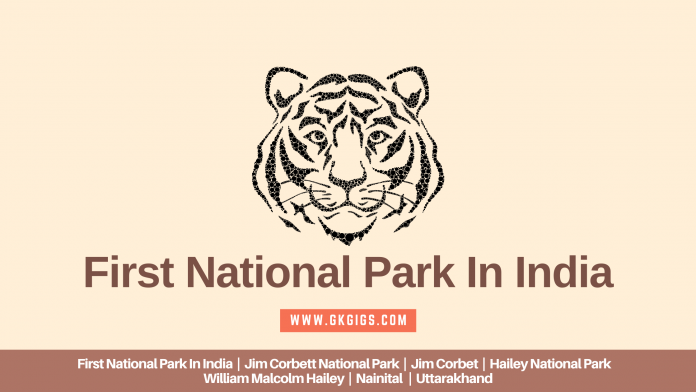
Last Updated: 27 November 2023
The first national park in India is the Jim Corbett National Park located in the Nainital District of Uttarakhand. Jim Corbett Park was established in 1936 during the British Raj.
Back then it was known as Hailey National Park named after William Malcolm Hailey who was a governor of the United Provinces in which it was located.
In 1956, nearly a decade after India’s independence, it was renamed Corbett National Park in honor of the hunter and naturalist Jim Corbett, who had played a leading role in its establishment and had died the year before.
Page Contents
Jim Corbett National Park At A Glance
| No. | Header | Details |
|---|---|---|
| 1 | Location | Nainital, Ramnagar |
| 2 | State | Uttarakhand |
| 3 | Pin | 244715 |
| 4 | Nearest city | Ramnagar, Kotdwar |
| 5 | Coordinates | 29°32′55″N 78°56′7″E |
| 6 | Area | 1,318 km² |
| 7 | Hills | 520.8 km2 |
| 8 | Elevation | 1,300 ft – 4,000 ft |
| 9 | Established | 1936 |
| 10 | Governing Body | 1) Project Tiger 2) Government of Uttarakhand 3) Wildlife Warden 4) Jim Corbett National Park |
10 Facts About Jim Corbett National Park
- Jim Corbett National Park is considered Asia’s first national park. It was the first to come under the Project Tiger initiative.
- The park has sub-Himalayan belt geographical and ecological characteristics.
- The Dense moist deciduous forest mainly consists of sal, Haldu, Peepal, Rohini, and Mango trees.
- Forest covers almost 73% of the park, while 10% of the area consists of grasslands.
- It houses around 580 Bird Species, 488 Species of Plants, 110 Tree Species, 50 Species of Mammals, and 25 Reptile Species.
- After the park was established in 1936, Hunting, Killing, Capturing of Mammals, Reptiles, and Birds were prohibited.
- Some areas of the park were formerly part of the princely state of Tehri Garhwal. The forests were cleared by the Environment and Forests Department (Uttarakhand) to make the area less vulnerable to Rohilla invaders.
- The Bengal tiger was the primary reason for the park’s creation.
- In 1973, India’s Project Tiger was founded to offer safe havens for tigers in the country’s national parks.
- The reserve was renamed in 1954–55 as Ramganga National Park and was again renamed in 1955–56 as Corbett National Park, after author and naturalist Jim Corbett.
History Of Jim Corbett Park
- During the Second World War Jim Corbett Park suffered from excessive poaching and timber cutting.
- Over time, the area in the reserve was increased to 797.72 km2, It was added in 1991 as a buffer zone to the Corbett Tiger Reserve.
- In 1974 the location of Jim Corbett Park was chosen for launching the Tiger Wildlife Conservation Project. The reserve is administered from its headquarters in the Nainital district.
- Corbett Park is one of the thirteen protected areas covered by the World Wide Fund For Nature under their Terai Arc Landscape Program.
- The program aims to protect three of the five terrestrial flagship species, the Tiger, the Asian Elephant, and the Great One-Horned Rhinoceros, by restoring corridors of forest to link 13 protected areas of Nepal and India to enable wildlife migration.
Location Of Jim Corbett Park
- The park is located between 29°25′ and 29°39’N latitude and between 78°44′ and 79°07’E longitude.
- The altitude of the region ranges between 360 m (1,181 ft) and 1,040 m (3,412 ft).
- It has numerous ravines, ridges, minor streams, and small plateaus with varying aspects and degrees of slope.
- It has a humid subtropical and highland climate.
- The core area forms Jim Corbett Park while the buffer contains reserve forests (496.54 km2) as well as the Sonanadi Wildlife Sanctuary (301.18 km2).
Climate Of Jim Corbett Park
- The weather in the Park is temperate compared to most other protected areas of India.
- The temperature varies from 5 °C (41 °F) to 30 °C (86 °F) during the winter and summer.
- Summer temperatures normally do not rise above 40 °C (104 °F).
- Rainfall ranges from light during the winter to heavy during the monsoonal summer.
- Heavy rainfall in the forest starts in July and ends in September.
Highlights
- The 2005 Bollywood movie Kaal has a plot set in Jim Corbett Park. The movie was filmed at the park as well.
- In August 2019, Prime Minister of India Narendra Modi appeared in a special episode of Discovery Channel’s show Man vs Wild with the host Bear Grylls, where he trekked the jungles and talked about nature and wildlife conservation with Grylls. The episode was filmed in Jim Corbett Park and broadcast in 180 countries alongside India.
- In 1985 David Hunt, a British ornithologist and birdwatching tour guide, was killed by a tiger in the park.
- The National Conservation Tiger Authority (NCTA) expressed serious concern that protection systems have weakened, and poachers have infiltrated into this park in April 2008.
- To protect the habitats of conservation-dependent species, India passed the Wild Life (Protection) Act in 1972 and Project Tiger in 1973.
Questions
Answer: Jim Corbett National Park
Answer: 1936
Answer: Nainital District, Ramnagar, Uttarakhand, 244715
Answer: Jim Corbett National Park
Answer: It has the highest number of tigers among other Indian National Parks.
Answer: The nearest Railway Station to Corbett Park is Ramnagar which is around 12 km from the park and the station is directly connected to the railway stations in Delhi.
Answer: 182 km via NH734 (3 hr 52 min Drive)
Answer: The Park has 252 Tigers (The Highest In The World)
Answer: Hailey National Park
Answer: The Gulf of Kutch (Jamnagar, Gujarat)
| Book Your Tickets From Uttarakhand’s Official Government Website. Click Here |
| Read More Interesting Articles |
- List Of Railway Minister Of India From 1947 To 2024
- List Of All International Airports In India (2024 Updated)
- Solicitor General Of India (2024 List Updated)
- List Of Indian State Foundation Day With GK Questions
- List Of The First Woman Of India In The Field Of Politics
- Attorney General Of India (2024 List Updated)












